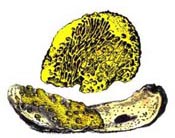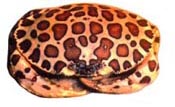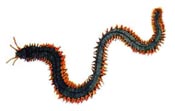 |
Black Sea Bass – Centropristes striatus A voracious feeder that roams the shallow limerock bottoms, devouring small crabs, shrimp and fish. Known to swallow hooks and sinkers. Breeding males have a distinctive bump on their forehead and turn a beautiful blue color. Family: Serranidae/Sea Bass |
 |
Blood Clam – Noetia ponderosa, a thick shelled clam with bright red blood, lives in sandy bottoms off barrier islands in the Gulf of Mexico. |
 |
Boring Sponge – Cliona celata, a bright yellow corn-cob shaped sponge that pumps water prominently through its canals and sometimes creates an up welling. In juvenile stages the sponge hollows out cavities in dead shell, and riddles it with holes which it replaces with its spongy tissues. |
 |
Calico Crab – Hepatus epheliticus, its brightly colored body blends with its surroundings. Often this crab stays buried beneath the sand, with only its eyes sticking up. However, when food is placed nearby, it pops out and shreds it with its sharp pinchers. It scavenges on worms, small clams, fish, etc. and is a favorite food of ridley sea turtles. |
 |
Clam Worm – Nerels limbata, the "ideal" polychaete worm used in research laboratories and school classrooms to demonstrate metamerism – the division of the body into segmented parts arranged in a linear series internally and externally. To the fisherman, this worm is best known as great bait for almost any fish. |
 |
Cloak Anemone – Calliactis tricolor, lives on hermit crabs and is a good example of true symbiosis. The stinging tentacles of the anemone gives the hermit crab protection from predatory octopuses and box crabs, and the anemone gets transportation and snatches food from the hermit crab's messy feeding. Hermits often fight over anemones and steal them from one another. |
| « Previous | Next » |






